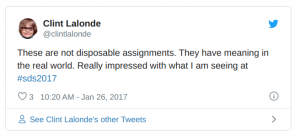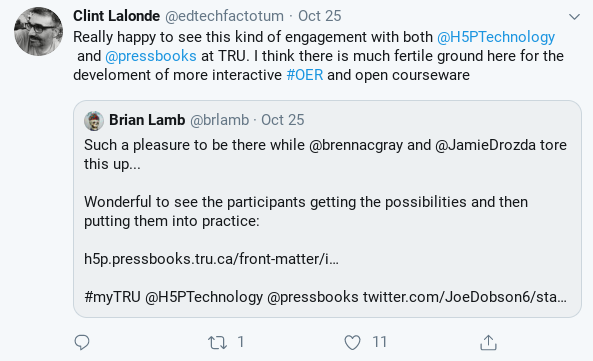Clint Lalonde is an educational technologist who advocates for the use of open educational resources and practices in higher education. He uses Twitter as a means of sharing ideas and information relating to teaching, learning & technology. He is currently the Manager of Education Technology at BC Campus as well as Associate Faculty in the School of Education and Technology at Royal Roads. His educational interests include network learning, social learning, open education, and open educational resources. Connecting to McLuhan’s Laws of Media, through Twitter, Lalonde can extend his voice globally while retrieving conversations that in the past would only have existed in face to face spaces (McLuhan, 2013).
 As a course designer, Lalonde provides leadership around collaborative projects that support the effective integration of technology and the building of community in online environments (Lalonde, n.d.). Educational theorist, philosopher, and reformer John Dewey viewed community as an integral aspect of education. Cummings (2000) argues that “concern about the deterioration of local community is central to John Dewey’s philosophy of education, democracy, and social reform” (p. 97). These are consistent with the ideas that Lalande includes in his tweets and blogs. Like Dewey, Lalonde views educational practices as a means of motivating students to understand that “they are contributing to something bigger and greater than themselves” (Lalonde, 2017).
As a course designer, Lalonde provides leadership around collaborative projects that support the effective integration of technology and the building of community in online environments (Lalonde, n.d.). Educational theorist, philosopher, and reformer John Dewey viewed community as an integral aspect of education. Cummings (2000) argues that “concern about the deterioration of local community is central to John Dewey’s philosophy of education, democracy, and social reform” (p. 97). These are consistent with the ideas that Lalande includes in his tweets and blogs. Like Dewey, Lalonde views educational practices as a means of motivating students to understand that “they are contributing to something bigger and greater than themselves” (Lalonde, 2017).
One of the best things about Lalonde is that he genuinely seems like a good person. Amongst his informative posts are posts like this one that talk about how he is making an effort to change and encourages others to as well.
Lalonde is specific in his diversity. He is an avid supporter of Open Education (OE), and Open Education Resources (OER), and tweets about issues that are closely or directly related to OE.
In addition to that, he is an advocate for both passion and respect. He promotes OE vigorously and passionately but ensures that he does so with tact and diplomacy as demonstrated by the following tweets.
Lalonde doesn’t focus on any one particular person or event. He retweets others who post topics relevant to OE, or provides shout outs to people who deserve recognition for what they have accomplished within the same field.
Lalonde’s Twitter feed is populated with posts about openness in regards to education, transparency of information, and diversity. Lalonde has tweeted about Wikipedia a few times, but in a recent Tweet, he made a plea to the public with a few simple, yet relatable reasons why Wikipedia should remain a free and open web source.
Lalonde also supports and promotes resources to help educators understand the First Peoples Principles of Learning and how to use them to support Indigenous learners.
Lalonde’s twitter feed is a bountiful resource of feminist advocacy tweets. These include retweets about issues women face when working in the technology field, links to feminist based web resources, and data that supports the need for more women in the field.
OER’s matter in education because they are readily available for educators to adapt and adopt and offer drastic savings in the cost of education. When educators open their materials and share them with the public it boosts opportunities for learning for both past and future students. Adopting OERs is a demonstration of social responsibility by providing equal access to education. Taylor (1996) stated that open education (open learning), focuses on “increasing quality and decreasing cost of mass higher education…” (p. 61).
Lalonde’s twitter feed advocates for students in a number of ways. He provides academic insights, coupled with real-world understanding as to how the current post-secondary educational system denotes more than just financial problems for the students of today. The following tweets highlight how the cost of additional materials for post-secondary education negatively impacts students, as well as offer an insight into some thoughts and ideas that have been voiced by students in relation to OE.
Lalonde stays current with topics that are relevant to education across Canada. He makes comments regarding political decisions in various provinces, takes note of what is happening at an elementary level, provides access to relevant literature, and ensures the public is informed about the latest and greatest news and ideas that come out of OE conferences.
Lalonde currently has 1,254 followers and is following 1, 526 others himself. There are several organizations that he follows and which are following him such as: OTESSA, ALT – alt.ac.uk, Global, Ontario Tech Open Educational Resources, TRU Open Education, MET Community, H5P, and Pressbooks. He follows, engages in discussions, and retweets several Educational Technologists such as Tom Woodward, Alan Levine, Amanda Coolidge, Brian Lamb, Maren Deepwell, Irwin DeVries, and Anne-Marie Scott to name a few. Here is a response to a tweet from Brian Lamb that references our own Jamie Drozda in it.

Lalonde leaves his twitter feed open-ended to allow for discourse amongst his followers. Taylor (1996) posits that lifelong learning itself has become an educational outcome. Lalonde provides this opportunity to all of his followers by posting up to the minute information from the many OE conferences that he attends. He also posts job opportunities that he comes across, as well as collaboration opportunities for interested parties.
His posts are also supported by moments of humour where a GIF is used to emphasize a point, or the sheer irony of something requires no words, simply a *sigh*.
Today, Twitter acts as a powerful platform for gathering and providing information, accessing relevant research and data, keeping up to date on news and events, and collaborating with peers and colleagues. Twitter itself has become an open education platform for sharing information, seeking clarification, promoting resources, accessing job opportunities, and staying up to date on current events. Taylor (1996) notes that Bates (1995) made an excellent point about how “technology is neither good nor bad in itself, but it is the way it is used that matters” (p.20). In the hands of someone like Lalonde, Twitter is a powerful and positive educational tool that can be accessed by anyone.
References
Cummings, C. K. (2000). John Dewey and the rebuilding of urban community: Engaging undergraduates as neighborhood organizers. Michigan Journal of Community Service Learning, 7, 97. Retrieved from https://quod.lib.umich.edu/m/mjcsl/3239521.0007.111?rgn=main;view=fulltext
Lalonde, C. (2017). Does open pedagogy require OER? [Blog post]. Retrieved from http://clintlalonde.net/2017/02/04/does-open-pedagogy-require-oer/
Lalonde, C. (n.d.). Clint Lalonde [Linkedin page]. Retrieved November 30, 2018, from https://ca.linkedin.com/in/clintlalonde
Mcluhan, M. (2013). Laws of the media. ETC: A Review of General Semantics, 70(4), 449-455. Retrieved from http://ezproxy.library.ubc.ca/login?url=http://search.ebscohost.com/login.aspx?direct=true&db=aph&AN=95509191&site=ehost-live&scope=site
Taylor, P. (1996). Chapter 3: Pedagogical Challenges of Open Learning: Looking to borderline issues. Counterpoints, 29, 59-77. Retrieved from www.jstor.org/stable/42975051

